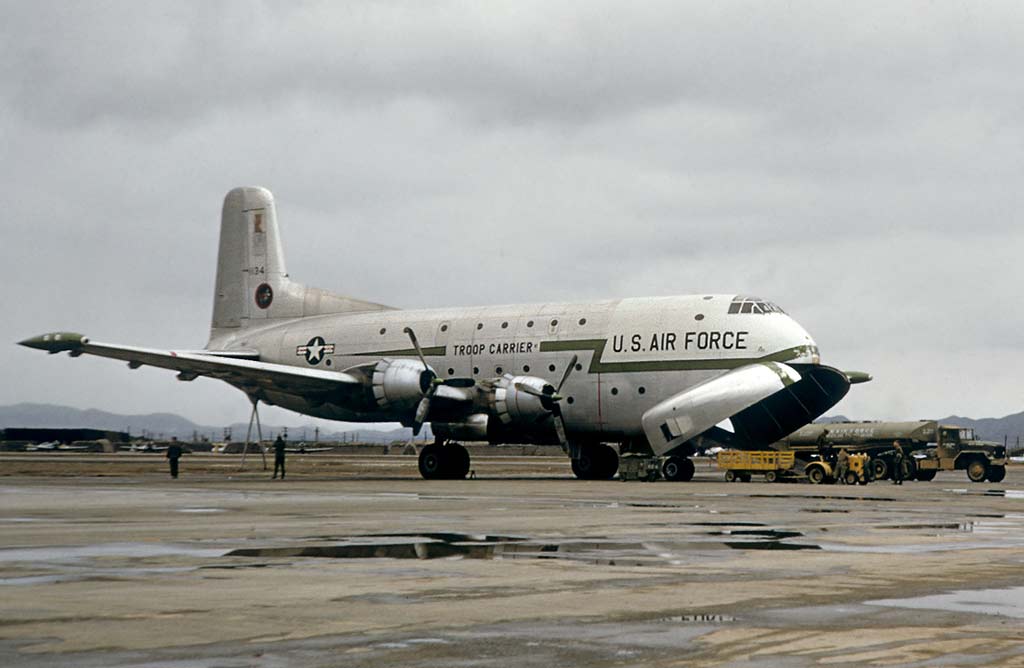Heavy-lift military transport aircraft, propeller-driven, four-engined, large-capacity, developed in the 1950s by Douglas Aircraft Company.
In brief
The Douglas C-124 Globemaster II, a strategic heavy-lift cargo aircraft, played a crucial role in post-WWII military operations. Developed by Douglas Aircraft Company, it was a response to the need for a large-capacity, long-range transport aircraft. First flown in 1949, it was distinguished by its unique clamshell loading doors and double-deck configuration, accommodating oversized cargo and troops. Powered by four Pratt & Whitney radial engines, the C-124 showcased remarkable performance for its time, with a considerable range and payload capacity. It served predominantly in the U.S. Air Force, participating in numerous military and humanitarian missions worldwide. The aircraft’s versatility and capability made it a cornerstone in Cold War-era logistics, until it was eventually superseded by jet-powered transports. The C-124 was retired from service in the 1970s, leaving a legacy of innovation in military aviation logistics.
The Douglas C-124 Globemaster II represents a significant leap in military aviation, marking an era of large-capacity air transport capable of global reach. This article delves into the comprehensive history, design, performance, variants, and military use of this remarkable aircraft.
History of the Development of the Douglas C-124 Globemaster II
Post-World War II saw significant shifts in geopolitical landscapes, necessitating rapid and large-scale transport capabilities for the United States military. The era was marked by the onset of the Cold War, where logistical prowess became as crucial as combat readiness.
The objective behind the development of the Douglas C-124 Globemaster II was to create a transport aircraft that could carry heavy and outsized military cargo, including tanks, trucks, and large troop contingents, over intercontinental distances. The development program was launched by the U.S. Air Force as a strategic initiative to strengthen its global military logistics.
The Douglas C-124 made its first flight on November 27, 1949. The program was initiated by the United States Air Force, recognizing the need for a more substantial and long-range cargo aircraft than its predecessor, the C-74 Globemaster.
Design of the Douglas C-124 Globemaster II
The C-124 was monumental in size and design. It had a length of 130 feet (39.62 meters), a wingspan of 174 feet (53.04 meters), and a height of 48 feet (14.63 meters). The aircraft featured a distinctive clamshell loading door and a double-deck configuration, allowing for the transportation of large cargo and troops simultaneously.
One of the significant advantages of the C-124 was its ability to transport heavy and oversized cargo over long distances. However, its reliance on propeller-driven engines and the relatively slow speed compared to later jet transports were among its drawbacks.
The C-124’s design set a precedent for future military transport aircraft, particularly in terms of cargo handling and capacity.

Performance
Powered by four Pratt & Whitney R-4360 ‘Wasp Major’ radial engines, each producing 3,800 horsepower, the C-124 had a formidable powerplant.
It had a cruise speed of 240 mph (386 km/h), a service ceiling of 21,800 feet (6,645 meters), and a range of 3,800 miles (6,115 kilometers) with a 10,000-pound (4,536 kg) payload.
When compared to contemporaries like the Lockheed C-130 Hercules, the C-124 was superior in terms of payload capacity but lagged in speed and operational flexibility.
Variants of the Douglas C-124 Globemaster II
The primary variants were the C-124A and the C-124C. The C-124C introduced more powerful engines and an improved APS-42 weather radar. Each variant had specific modifications tailored to their operational roles.
Military Use and Combat of the Douglas C-124 Globemaster II
As a cargo aircraft, the C-124 was not armed. Its military use was primarily in logistics, troop transport, and humanitarian missions.
The C-124 played a crucial role in the Korean War and the Vietnam War, transporting essential supplies, equipment, and personnel. It was also vital in numerous humanitarian missions and disaster relief operations.
Competitors included the Lockheed C-130 Hercules and the Soviet Antonov An-22. The C-124 was primarily used by the U.S. Air Force and was not widely sold to other countries.
The Globemaster II was eventually replaced by jet-powered transports like the C-141 Starlifter and the C-5 Galaxy. It was officially retired from service in the 1970s.
The Douglas C-124 Globemaster II marked an era in military aviation, setting new standards in air transport. Its contribution to military logistics and humanitarian efforts leaves a lasting legacy in the annals of aviation history. The aircraft’s retirement marked the end of an era and the beginning of modern air transport capabilities, underscoring the evolution of military logistics in the jet age.
Back to Transport planes.